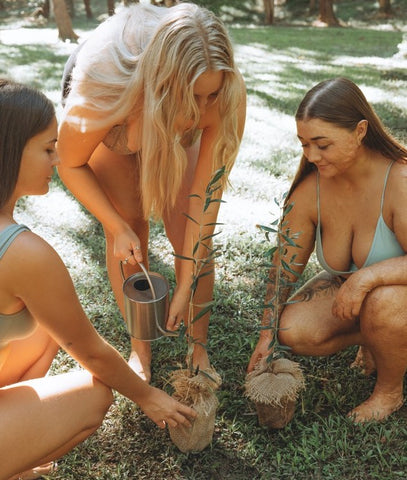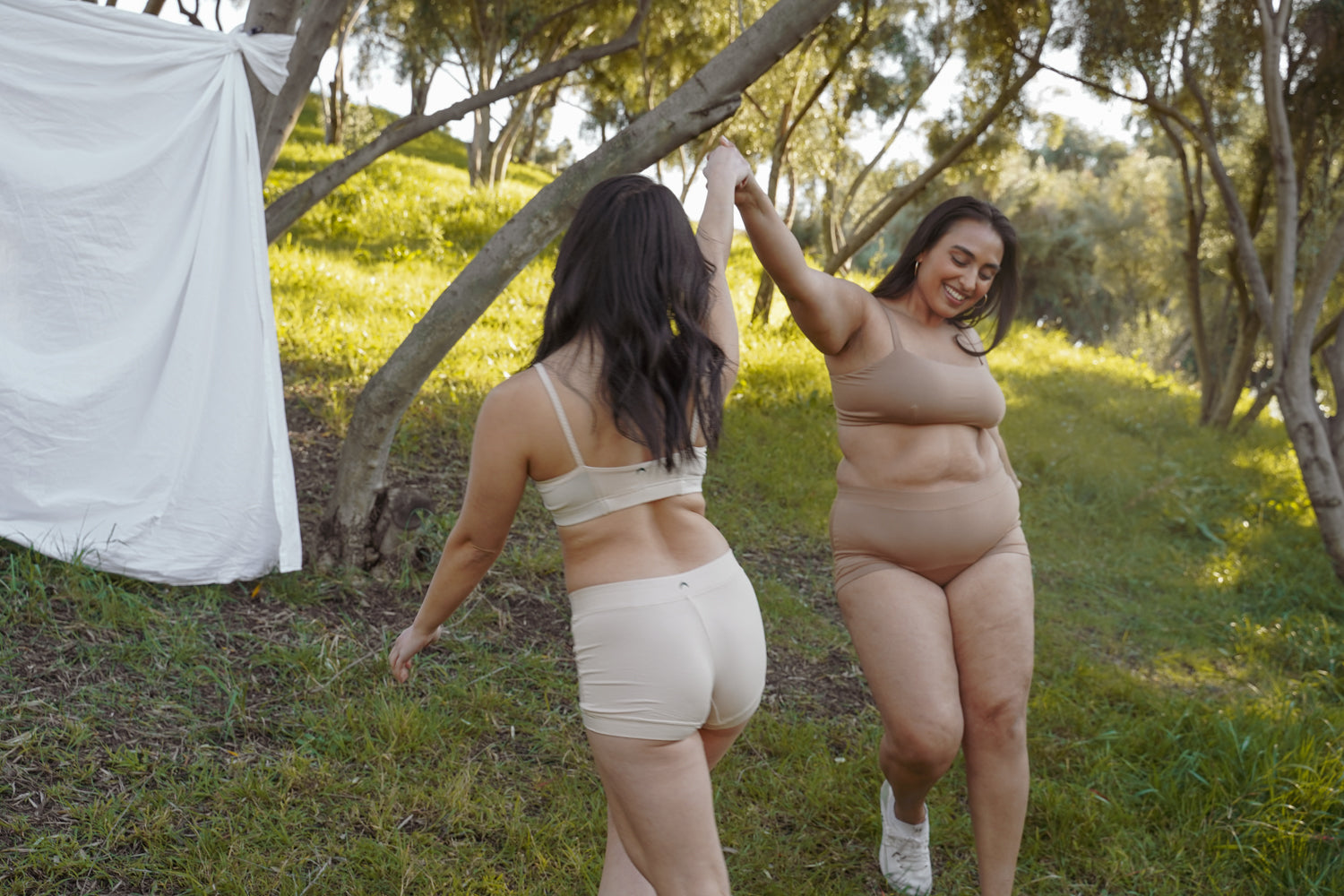Earth Month: What is Sustainable Fashion?
We all know that April 22 is Earth Day but did you also know that April is Earth Month? Through an unbelievable and amazing ordered combination of factors, this spinning ball of earth provides perfect conditions for our human lives to flourish. Even though we should be celebrating our home planet every day of the year, April is a good time to really consider your environmental impact and how you can change your behaviour as a consumer to better serve the planet.
In this Earth Month inspired blog post, we will be discussing:
- What does sustainability mean
- Why should we choose sustainable and ethical brands
- How to find out if your fabric choices are sustainable
- Huha’s Earth Month promotion!
What does sustainability mean?

With our rapidly increasing numbers, technological advances, use of non-renewable resources and lack of concern for where we dump our wastes, we’re upsetting the balance of our planet. Textile waste is one of the biggest problems worldwide. Fast Fashion is far from sustainable, a staggering two-thirds of our clothing is made from fossil fuel synthetics. It depletes the Earth’s natural resources at exponential rates, exploits workers around the world, and results in an overwhelming amount of waste. In fact 85% of this material is sent to landfills, unable to ever decay or decompose. What can we do?
You’ve definitely heard or used the term sustainable fashion at some point, but what does it actually mean?
The word sustainable is defined as “capable of being sustained.” Therefore, a sustainable fashion industry is one that must operate in ways that can continue working for years and decades to come.
Fashion can be made more sustainable in numerous throughout the design process, manufacturing and distribution phases. A few examples include:
Design
- Using organic and biodegradable materials (Learn more about the life cycle analysis of textiles in our Fabric Guide: How To Choose The Best Eco-Friendly & Sustainable Fabrics)
- Biodegradable dyes
- Clear care label/instructions - to extend life of garment
All Huha anti-bacterial thongs, cheekies and briefs are made from TENCEL™ Modal and Lyocell cellulose fabrics which are sustainably from beech and eucalyptus wood pulp. They are highly durable, versatile have a long life space and are completely biodegradable!
Manufacturing
- Engineering patterns that create zero waste
- Fair wages and safe working conditions
- Closed Loop Production - closed-loop systems reuse material waste created during the production process as well as use recycled products to make new ones.
TENCEL™ Lyocell fibres have gained a commendable reputation for their environmentally responsible closed loop production process, with high resource efficiency and low environmental impact.
Distribution
- Sustainable packaging
At Huha we use zero plastic when packing your undies orders and try to use a minimal amount of material, which includes recycled envelopes and soluble/biodegradable packing materials.
Why should we choose sustainable and ethical brands?

Sustainable Usually Means Quality
Sustainable brands focus on quality and longevity. Using materials that will last and are kind to the environment. By investing in sustainable brands, you are choosing to reduce the amount of waste created by fast fashion and also perhaps save money with garments and underwear that stands the test of time.
It’s Better For The Planet
The fast fashion industry leaves behind a huge environmental footprint. From the landfill impact, and power and water consumption, to the pesticides and insecticide used in growing cotton and the chemicals that are making their way into the water supply and affecting the health of those in the supply chain, it’s safe to say fast fashion is a real problem for the environment. By choosing sustainable fashion you are reducing this environmental footprint.
Supporting Small and Local Business
Small businesses and independent entrepreneurs are making the biggest impact in reducing the carbon footprint of business, as stated in a report by Changemakers.com. “Entrepreneurs are the solution to global warming. Small and medium sized enterprises (SMEs) are at the forefront of saving the environment.”
In fact, when you support (many, if not most of the) sustainable fashion and underwear brands, you will be supporting a small, independent business (like Huha!) and not a multi-million dollar corporation. Small and local businesses are more accountable to their communities, donate more money to non-profits and often have a smaller carbon footprint! Yay!
Because You’re A Good Person
Going green and choosing sustainable fashion is not an easy or an inexpensive decision to make. The lure of the easy, cheap, behemoth that is fast-fashion is hard to ignore, especially when you are strapped for cash and trying to be sustainable in all areas of your life. We don’t expect you to be the saint of sustainability. But if you have an inherent desire to protect the environment, we recommend starting with small changes to your wardrobe - perhaps starting with your underwear drawer? 😉
How to find out if your fabric choices are sustainable
It can be difficult to know for sure if you are actually browsing sustainable options, especially when brands take part in ‘Greenwashing.’
Greenwashing is the process of conveying a false impression or providing misleading information about how their products are made from environmentally friendly fabrics. It is considered to be an unsubstantiated claim to deceive consumers and can be hard to see-through.
Unfortunately, there is no universal standard in the EU, UK, or the USA for what qualifies as ‘sustainable’ or ‘environmentally-conscious’ clothing. As a consumer, you have to determine how eco-friendly a product is on your own – and brands are great at advertising themselves to seem more sustainable than they actually are.
Things to look out for when shopping for sustainable fashion and underwear brands:
Low Impact Organic/Raw Materials
Natural fibres such as hemp, linen, conventional cotton, organic cotton, wool, leather, and cellulose fibres (i.e., synthetically made fibres originating from plant sources, including viscose, rayon, lyocell, etc.) are generally preferable over petroleum-derived synthetics like polyester, acrylic, and nylon. (Check out Fabric Guide blog post to learn more)
That said, some natural materials are more sustainable than others, with hemp, linen, organic cotton and cellulose fabrics generally being among the most environmentally friendly.
Pro tip: Where possible, keep an eye out for organic certifications, like the Global Organic Textile Standard (GOTS) for plant-based fibres and ethical indications and standards for wool, such as ZQ-certified wool.
For cellulosic fabrics, look to prioritize lyocell or TENCEL™ by Lenzing - an industry leader in innovating environmentally conscious fibres.
Recycled Materials
Look for brands that use pre-existing materials to create new clothing as it does not require the extraction of new resources from the Earth.
Pro tip: Look for fabrics made of recycled fibres (e.g., recycled nylon, recycled polyester (rPET), recycled cotton), clothes made of up-cycled materials (repurposed fabric), or clothes made from deadstock fabric (materials created, never sold nor used and would otherwise be thrown away).
Eco-friendly Dyes and Bluesign or OEKO-TEX Certifications
It’s important to consider the environmental impact of the dyes and textile treatment processes. Many dye and finishing processes involve enormous amounts of water and the use of toxic chemicals.
Pro tip: Eco-friendly dyes include ones from digital printing that require less water, natural, plant-based dyes, and certified nontoxic dyes. Look for the Bluesign or OEKO-TEX 100 certifications.
Zero/Low Waste Design
Some brands aim to reduce waste by eliminating excessive plastic packaging when transporting from the manufacturer, to the warehouse, and to the customer; and/or ship in bulk and use recycled or biodegradable packing materials.
Pro tip: Look for brands that make it a priority to minimize byproduct waste in their manufacturing process and excessive packaging materials during transport. Follow them on social media to learn more about this aspect of their business.
Second-Hand & Durable Clothing
You can be a responsible consumer by taking care of your clothes to prolong their lives or buying secondhand, which keeps clothes out of landfills for longer.
Pro tip: Prioritize durability and high quality clothes. Wash clothes in cold water, and hang them to dry. Mend clothes and make simple alterations when necessary.
Earth Month at Huha

Small business doesn’t always have to mean small impact. 👊🏼
From our fabric choices to our packaging, our goal at Huha is to reduce our environmental impact by creating a sustainable product using sustainable materials, that we are proud to sell.
Our Mineral Undies are designed with award-winning TENCEL™ Modal and Lyocell fabrics which are made sustainably, from beech and eucalyptus trees.
For Earth Month 2021 we truly wanted to bring our design, manufacturing and distribution processes full circle, which is why we promise to plant one eucalyptus tree with every order/pre-order of Huha undies, purchased during the month of April!
1 x Undies Order = 1 Eucalyptus Tree Planted
Every time you place an order, you will be responsible for planting a tree that will help make the next pair of undies! Woohoo! Place your order here.








